Easter Greetings from Copacabana!
 Dear Friends and Family,
Dear Friends and Family,
Easter Greetings from Copacabana! We hope this time of resurrection and renewal fills and refreshes your hearts. It's a season of new beginnings.
A year ago we arrived in Copacabana on the Wednesday before Easter with some clothes, cookware and a few books packed into four bags. We were lucky to have made hostel reservations in advance because thousands of people travel to Copa for the last days of Holy Week. It seems even more crowded this year.
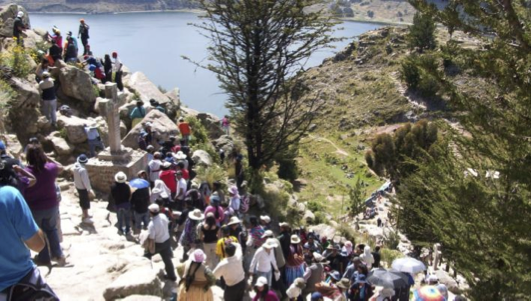
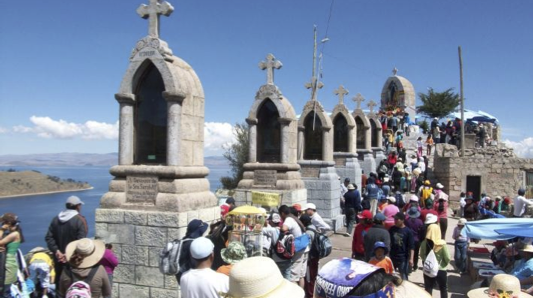
People from all over South America, especially Bolivia, make pilgrimages to Copacabana in these High Holy Days. About 2000 people walk or bike the 158-km distance from La Paz to Copa to do penance at the Stations of the Cross on Cerro Calvario, which is easily visible from our house. At dusk on Good Friday, a solemn candlelit procession of thousands of pilgrims marched through the town, led by a statue of Christ in a glass coffin and a replica of the Virgen Morena del Lago (Dark Virgin of the Lake).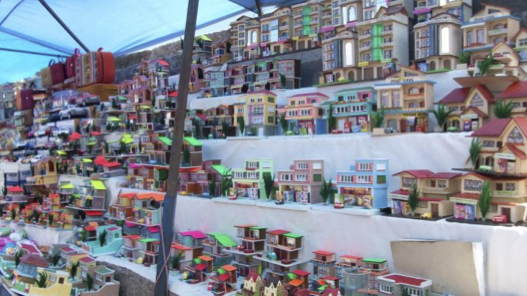 At the summit of Calvario they light incense and purchase miniatures representing material possessions in the hope that the Virgin will grant the real things in the coming year. They also drag all manner of things up there, including their childrens' strollers, tricycles, and bikes, to be blessed for safety.
At the summit of Calvario they light incense and purchase miniatures representing material possessions in the hope that the Virgin will grant the real things in the coming year. They also drag all manner of things up there, including their childrens' strollers, tricycles, and bikes, to be blessed for safety.
The history of the Dark Virgin is interesting. While the Incas were in power they divided the locals into two groups: those faithful to the empire were the Haransaya, who were assigned positions of power. Resisters were the Hurinsaya, who were relegated to manual labor. The separation went entirely against the community-oriented Aymara culture. They attributed the floods and crop failures that befell them in the 1570s to this social aberration.
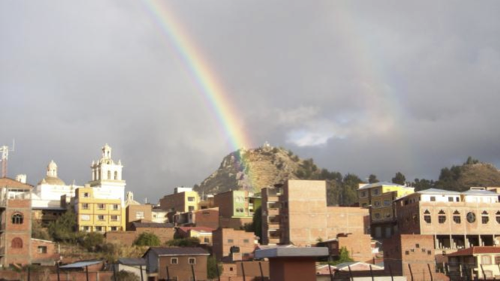
Calvario and Cathedral as viewed from our livingroom
And they rejected the Inca religion and partly adopted Christianity. They elected La Santisima Virgen de Candelaria as their patron saint and established a congregation in her honor. Francisco Tito Yupanqui, grandson of the last Inca emperor, initially fashioned a clay image of the Virgen for the adobe altar. But his rude effort was deemed unsuitable to represent the honored patron saint of the village and was removed. 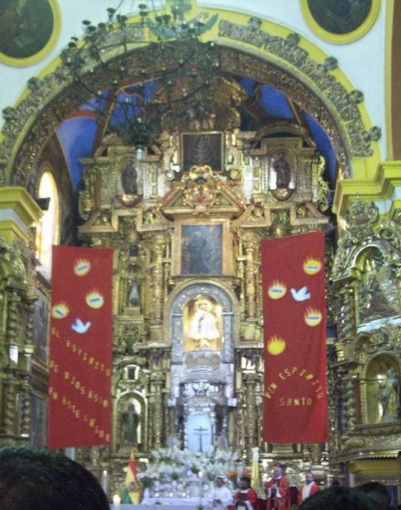 Humiliated but not defeated, Tito Yupanqui journeyed to Potosi to study the arts. In 1582 he began an eight-month mission to carve a wooden statue that was completed and installed in 1583. Shortly thereafter the miracles began. There were reportedly "innumerable" early healings. Copa quickly became a pilgrimage site, and has remained so ever since. The statue is never moved from the cathedral, as superstition suggests that its disturbance would precipitate a devastating flood of Lake Titicaca. In fact, a lot of locals decry the practice of taking even the replica on procession. Some blame this year's Ash Wednesday procession for the extra month of rain beyond the usual mid- March end of the rainy season.
Humiliated but not defeated, Tito Yupanqui journeyed to Potosi to study the arts. In 1582 he began an eight-month mission to carve a wooden statue that was completed and installed in 1583. Shortly thereafter the miracles began. There were reportedly "innumerable" early healings. Copa quickly became a pilgrimage site, and has remained so ever since. The statue is never moved from the cathedral, as superstition suggests that its disturbance would precipitate a devastating flood of Lake Titicaca. In fact, a lot of locals decry the practice of taking even the replica on procession. Some blame this year's Ash Wednesday procession for the extra month of rain beyond the usual mid- March end of the rainy season.
In 1605 the Augustinian priesthood advised the community to build a cathedral commensurate with the power of the image. The altar, made with 20,000 pounds of Incan silver and gold, was completed in 1614, but work on the building continued for 200 years. The Moorish- style cathedral was consecrated in 1805, but construction wasn't completed until 1820.
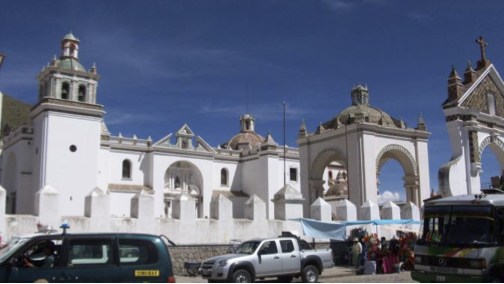
Above: Interior and exterior views of the cathedral
Just a smidgeon of history to go along with our Easter greetings to you all.
Tomorrow we will think fondly and yearningly of you, and of your baked ham and roasted lamb dinners!
With Much Love,
Deb and Jeff
- Debbie Rissing's blog
- Log in to post comments
God, as known to us in Jesus Christ, welcomes all.
We welcome people of any race, national origin, ethnicity, gender, sexual orientation, age, social or economic status, employment status, or life situation; including people with physical or mental illness or disability.
We practice loving acceptance of each person and respectful discussion
 of our differences.
of our differences.
Affiliated to Reconciling Ministries Network
Recent News
Sunday Worship Service - July 30 at 10:00 am
July 30, 2023 - 9:51am
Sunday Worship Service - July 23 at 10:00 am
July 23, 2023 - 9:48am
Sunday Worship Service - July 16 at 10:00 am
July 16, 2023 - 10:17am
Vacation Bible School
July 14, 2023 - 10:10pm
Sunday Worship Service - July 9 at 10:00 am
July 9, 2023 - 9:53am






